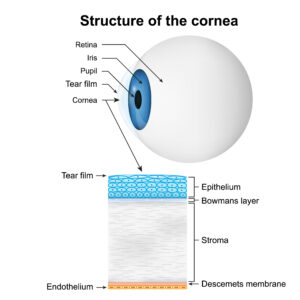Vision correction procedures are an excellent option for anyone with a refractive error who wants an alternative to glasses and contact lenses. LASIK and other refractive laser eye procedures are the most popular.
But if you’re over 45, chances are you have some degree of presbyopia. Presbyopia can affect your ability to see up close.
It also can’t be corrected with traditional refractive laser eye procedures like LASIK. However, you can correct it with a procedure called refractive lens exchange.
Refractive lens exchange, or RLE, is a procedure that can correct refractive errors and presbyopia. Keep reading to learn why refractive lens exchange is the best choice if you have presbyopia!
What is Presbyopia?

Presbyopia is a condition that affects most adults by the time they are in their forties or fifties. As you age, parts of your body lose muscle strength and elasticity, including parts of your eye.
Specifically, presbyopia occurs when your eye’s natural lens becomes less flexible. Your lens changes shape to focus on nearby objects.
When it lacks flexibility, it can’t move as much. Because the lens can’t move as it once could, it can no longer focus as much. This is why adults with presbyopia struggle to see up close.
Refractive errors like nearsightedness, farsightedness, and astigmatism occur as a result of the shape of the cornea. The cornea is the transparent outer layer of your eye.
People of any age can have or develop refractive errors. But presbyopia is an age-related condition that isn’t affected by the shape of the cornea. Traditional laser eye procedures like LASIK cannot correct presbyopia; that is where refractive lens exchange comes in.
Laser Vision Correction Procedures

Refractive laser eye procedures like LASIK will correct refractive errors like nearsightedness, farsightedness, and astigmatism. LASIK works because it reshapes and changes the shape of the cornea.
It uses an excimer laser and a femtosecond laser to remove small amounts of tissue from the cornea. Removing this tissue sculpts the cornea into a new shape that corrects the patient’s specific refractive error.
While patients with presbyopia can have LASIK to correct a refractive error, it won’t help presbyopia. If they have LASIK, they will still need to wear reading glasses after the vision correction procedure.
But refractive lens exchange can correct both during the same procedure. That makes RLE ideal for anyone with presbyopia and refractive errors.
What is Refractive Lens Exchange?

Refractive lens exchange is a vision correction procedure that removes the natural lens from the eye by creating a small incision. Then an ultrasonic instrument is used to gently break apart the lens, which is then removed through the incision.
After removing your natural lens, your surgeon replaces it with an artificial lens called an intraocular lens, or IOL. The IOL is folded up and inserted through the incision to unfurl.
It’s then positioned in the appropriate place. The incision is small enough that it heals on its own without any need for stitches.
By replacing your natural lens with an IOL, refractive lens exchange allows you to see better while correcting presbyopia and refractive errors during the same procedure. But the degree to which RLE can correct your vision depends on your chosen intraocular lens.
Refractive Lens Exchange and IOLs
There are several different kinds of IOLs. Each one is designed differently and has distinct advantages.
The most standard and basic option for intraocular lenses is the monofocal lens. Monofocal lenses are the least expensive and the only IOLs covered by health insurance.
With a monofocal IOL, the lens is uniform all over and set to one refractive power. They can help you see either up close or far away.
If you choose a monofocal lens, you will still need glasses to compensate for other distances not corrected during refractive lens exchange. Another option with monofocal lenses, although it is rarer, is monovision.
With monovision, you’ll have one lens put in one eye to see up close and another lens in the other to help you see things at a distance. The result is good enough vision when you’re looking at most distances.
However, it’s important to realize that monovision only works for some. It may also not provide you with the clearest vision. For the best vision, you’ll need to choose a premium IOL.
Premium IOLs are designed to correct presbyopia and refractive errors to a higher degree. They also eliminate the need for reading glasses and other visual aids.
Some are also specifically designed to correct astigmatism. When you get refractive lens exchange, talk to your New England Eye Center ophthalmologist about their premium IOL options. They can discuss your best options based on your lifestyle and visual needs.
Another Advantage: No Cataracts

Refractive lens exchange is the best choice for vision correction if you have presbyopia. In addition to giving you clear vision and eliminating the need for glasses and contact lenses (depending on what IOL you choose), it also prevents you from developing cataracts.
Cataract surgery and RLE are almost identical procedures. The most significant difference between these two procedures is that you don’t need cataracts to undergo refractive lens exchange. But because cataracts can only form on the natural lens and can’t form on an IOL, you can’t get cataracts after having refractive lens exchange.
If you have refractive lens exchange before you develop cataracts, you can give yourself better vision and ensure that you never experience vision loss from cataracts. To learn more and determine if RLE is right for you, schedule an appointment at New England Eye Center in Boston, MA!
If you don’t want cataracts and want better vision, why not find out if you could be a good candidate for refractive lens exchange?




